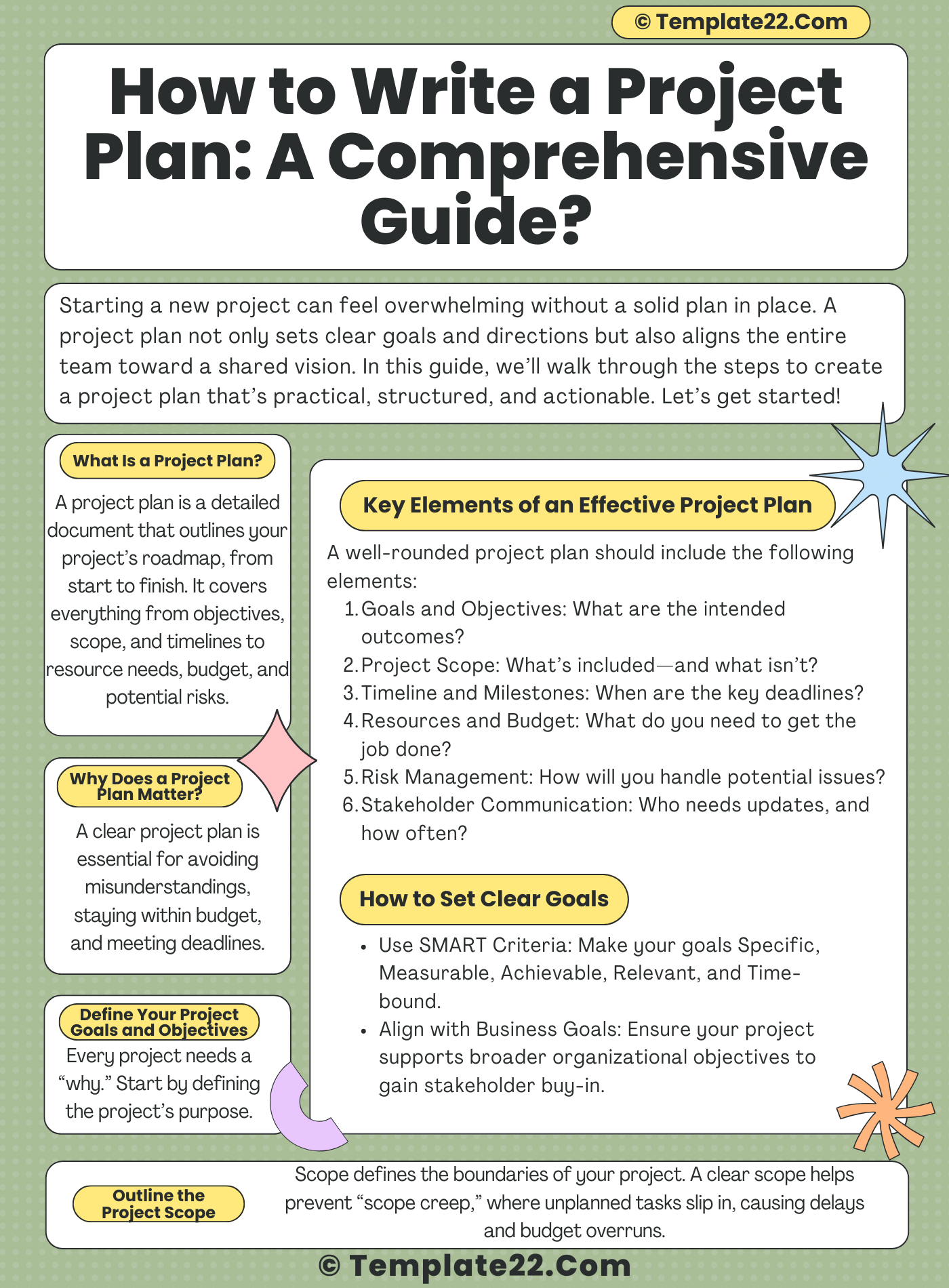 Starting a new project can feel overwhelming without a solid plan in place. A project plan not only sets clear goals and directions but also aligns the entire team toward a shared vision. In this guide, we’ll walk through the steps to create a project plan that’s practical, structured, and actionable. Let’s get started!
Starting a new project can feel overwhelming without a solid plan in place. A project plan not only sets clear goals and directions but also aligns the entire team toward a shared vision. In this guide, we’ll walk through the steps to create a project plan that’s practical, structured, and actionable. Let’s get started!
What Is a Project Plan?
A project plan is a detailed document that outlines your project’s roadmap, from start to finish. It covers everything from objectives, scope, and timelines to resource needs, budget, and potential risks. Think of it as the master plan that helps everyone involved understand what needs to happen, by when, and how.
Why Does a Project Plan Matter?
A clear project plan is essential for avoiding misunderstandings, staying within budget, and meeting deadlines. It also helps team members stay focused and gives stakeholders confidence that the project is well-organized and set up for success.
Key Elements of an Effective Project Plan
A well-rounded project plan should include the following elements:
- Goals and Objectives: What are the intended outcomes?
- Project Scope: What’s included—and what isn’t?
- Timeline and Milestones: When are the key deadlines?
- Resources and Budget: What do you need to get the job done?
- Risk Management: How will you handle potential issues?
- Stakeholder Communication: Who needs updates, and how often?
Step 1: Define Your Project Goals and Objectives
Every project needs a “why.” Start by defining the project’s purpose. What are you aiming to achieve? Be specific. Instead of saying “improve efficiency,” set a measurable goal, like “reduce processing time by 20%.”
CLICK HERE TO DOWNLOAD 300+ PROJECT MANAGEMENT TEMPLATES & DOCUMENTS IN EXCEL
How to Set Clear Goals
- Use SMART Criteria: Make your goals Specific, Measurable, Achievable, Relevant, and Time-bound.
- Align with Business Goals: Ensure your project supports broader organizational objectives to gain stakeholder buy-in.
Step 2: Outline the Project Scope
Scope defines the boundaries of your project. A clear scope helps prevent “scope creep,” where unplanned tasks slip in, causing delays and budget overruns.
Tips for Setting Scope
- Define Deliverables: List the key outputs the project will produce.
- Highlight Exclusions: Note any tasks or items that are out of scope to prevent misunderstandings.
- Get Stakeholder Approval: Ensure everyone agrees on the scope before moving forward.
Step 3: Develop a Realistic Timeline
Creating a timeline with clear milestones keeps the project moving steadily. Break down the project into phases, each with its deadline, and map dependencies between tasks.
How to Build a Strong Timeline
- Identify Dependencies: Make note of tasks that rely on other tasks to be completed first.
- Set Milestones: These help track progress and motivate the team.
- Include a Buffer: Unexpected delays happen, so add extra time to avoid unnecessary stress.
Step 4: Allocate Resources and Budget
Resource planning and budgeting are critical to ensure the project stays within financial limits and has the support it needs. Define what you need in terms of people, equipment, software, or any other resources.
Budgeting Tips
- Account for Both Fixed and Variable Costs: List out all anticipated expenses, from salaries to materials.
- Plan for Contingencies: Set aside a portion of the budget for unexpected costs.
- Monitor Regularly: Regular check-ins with your budget help catch issues before they escalate.
Step 5: Identify Risks and Create a Risk Management Plan
Risk management is about being proactive rather than reactive. Identify potential risks, assess their likelihood, and have a plan for how to handle them.
Common Project Risks
- Resource Risks: Team members might be unavailable or lack the skills needed.
- Timeline Risks: Delays in one area can cause a chain reaction.
- Budget Risks: Unplanned expenses can quickly add up.
Step 6: Develop a Stakeholder Communication Plan
For a project to be successful, stakeholders need to be informed and engaged. Outline who needs updates, what information they need, and when they’ll receive it. Effective communication reduces misunderstandings and keeps everyone aligned.
How to Communicate with Stakeholders
- Establish a Communication Schedule: Regular updates keep everyone in the loop.
- Tailor the Information: Share the right level of detail with each group.
- Encourage Transparency: Keep stakeholders aware of progress and any challenges.
CLICK HERE TO DOWNLOAD 300+ PROJECT MANAGEMENT TEMPLATES & DOCUMENTS IN EXCEL
Finalizing and Reviewing Your Project Plan
With each section complete, review the plan with key stakeholders. Address any concerns, make adjustments, and get final approval. Remember, a project plan isn’t a rigid document; it should be flexible enough to adapt as the project progresses.
Key Takeaways for Writing a Project Plan
- Use Project Management Tools: Tools like Trello, Asana, or Smartsheet can make planning and tracking easier.
- Communicate Clearly: Regular updates keep the team aligned and stakeholders informed.
- Stay Flexible: Be ready to adjust the plan as the project evolves.
A thorough project plan sets the stage for a successful project. By following these steps, you can create a plan that guides your team, keeps stakeholders informed, and ensures your project stays on track from start to finish.
